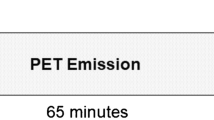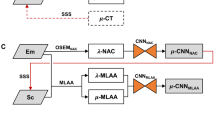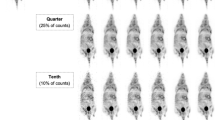Abstract
A novel deep learning (DL)-based attenuation correction (AC) framework was applied to clinical whole-body oncology studies using 18F-FDG, 68 Ga-DOTATATE, and 18F-Fluciclovine. The framework used activity (λ-MLAA) and attenuation (µ-MLAA) maps estimated by the maximum likelihood reconstruction of activity and attenuation (MLAA) algorithm as inputs to a modified U-net neural network with a novel imaging physics-based loss function to learn a CT-derived attenuation map (µ-CT).
Methods
Clinical whole-body PET/CT datasets of 18F-FDG (N = 113), 68 Ga-DOTATATE (N = 76), and 18F-Fluciclovine (N = 90) were used to train and test tracer-specific neural networks. For each tracer, forty subjects were used to train the neural network to predict attenuation maps (µ-DL). µ-DL and µ-MLAA were compared to the gold-standard µ-CT. PET images reconstructed using the OSEM algorithm with µ-DL (OSEMDL) and µ-MLAA (OSEMMLAA) were compared to the CT-based reconstruction (OSEMCT). Tumor regions of interest were segmented by two radiologists and tumor SUV and volume measures were reported, as well as evaluation using conventional image analysis metrics.
Results
µ-DL yielded high resolution and fine detail recovery of the attenuation map, which was superior in quality as compared to µ-MLAA in all metrics for all tracers. Using OSEMCT as the gold-standard, OSEMDL provided more accurate tumor quantification than OSEMMLAA for all three tracers, e.g., error in SUVmax for OSEMMLAA vs. OSEMDL: − 3.6 ± 4.4% vs. − 1.7 ± 4.5% for 18F-FDG (N = 152), − 4.3 ± 5.1% vs. 0.4 ± 2.8% for 68 Ga-DOTATATE (N = 70), and − 7.3 ± 2.9% vs. − 2.8 ± 2.3% for 18F-Fluciclovine (N = 44). OSEMDL also yielded more accurate tumor volume measures than OSEMMLAA, i.e., − 8.4 ± 14.5% (OSEMMLAA) vs. − 3.0 ± 15.0% for 18F-FDG, − 14.1 ± 19.7% vs. 1.8 ± 11.6% for 68 Ga-DOTATATE, and − 15.9 ± 9.1% vs. − 6.4 ± 6.4% for 18F-Fluciclovine.
Conclusions
The proposed framework provides accurate and robust attenuation correction for whole-body 18F-FDG, 68 Ga-DOTATATE and 18F-Fluciclovine in tumor SUV measures as well as tumor volume estimation. The proposed method provides clinically equivalent quality as compared to CT in attenuation correction for the three tracers.







Similar content being viewed by others
References
Barrett JF, Keat N. Artifacts in CT: recognition and avoidance. Radiographics. 2004;24:1679–91. https://doi.org/10.1148/rg.246045065.
Ladefoged CN, Law I, Anazodo U, St Lawrence K, Izquierdo-Garcia D, Catana C, et al. A multi-centre evaluation of eleven clinically feasible brain PET/MRI attenuation correction techniques using a large cohort of patients. Neuroimage. 2017;147:346–59. https://doi.org/10.1016/j.neuroimage.2016.12.010.
Chen Y, An H. Attenuation correction of PET/MR imaging. Magn Reson Imaging Clin N Am. 2017;25:245–55. https://doi.org/10.1016/j.mric.2016.12.001.
Rezaei A, Defrise M, Bal G, Michel C, Conti M, Watson C, et al. Simultaneous reconstruction of activity and attenuation in time-of-flight PET. IEEE Trans Med Imaging. 2012;31:2224–33. https://doi.org/10.1109/TMI.2012.2212719.
Rezaei A, Deroose CM, Vahle T, Boada F, Nuyts J. Joint reconstruction of activity and attenuation in time-of-flight pet: a quantitative analysis. J Nucl Med. 2018;59:1630. https://doi.org/10.2967/jnumed.117.204156.
Hwang D, Kang SK, Kim KY, Seo S, Paeng JC, Lee DS, et al. Generation of PET attenuation map for whole-body time-of-flight (18)F-FDG PET/MRI using a deep neural network trained with simultaneously reconstructed activity and attenuation maps. J Nucl Med. 2019;60:1183–9. https://doi.org/10.2967/jnumed.118.219493.
Shi L, Onofrey J, Revilla EM, Toyonaga T, Menard D, Ankrah J, et al. A novel loss function incorporating imaging acquisition physics for PET attenuation map generation using deep learning. Med Image Comput Comput Assist Interv. 2019;11767:723–31. https://doi.org/10.1007/978-3-030-32251-9_79.
Maurer T, Eiber M, Schwaiger M, Gschwend JE. Current use of PSMA-PET in prostate cancer management. Nat Rev Urol. 2016;13:226–35. https://doi.org/10.1038/nrurol.2016.26.
Calais J, Ceci F, Eiber M, Hope TA, Hofman MS, Rischpler C, et al. (18)F-fluciclovine PET-CT and (68)Ga-PSMA-11 PET-CT in patients with early biochemical recurrence after prostatectomy: a prospective, single-centre, single-arm, comparative imaging trial. Lancet Oncol. 2019;20:1286–94. https://doi.org/10.1016/S1470-2045(19)30415-2.
Poeppel TD, Binse I, Petersenn S, Lahner H, Schott M, Antoch G, et al. 68Ga-DOTATOC versus 68Ga-DOTATATE PET/CT in functional imaging of neuroendocrine tumors. J Nucl Med. 2011;52:1864–70. https://doi.org/10.2967/jnumed.111.091165.
Panin VY, Aykac M, Casey ME. Simultaneous reconstruction of emission activity and attenuation coefficient distribution from TOF data, acquired with external transmission source. Phys Med Biol. 2013;58:3649–69. https://doi.org/10.1088/0031-9155/58/11/3649.
Onofrey JA, Casetti-Dinescu DI, Lauritzen AD, Sarkar S, Venkataraman R, Fan RE, et al. Generalizable multi-site training and testing of deep neural networks using image normalization. Biomedical Imaging (ISBI), 2019 IEEE 16th International Symposium on; 2019. p. pp. 1–4.
Ronneberger O, Fischer P, Brox T. U-Net: Convolutional networks for biomedical image segmentation. Cham: Springer International Publishing; 2015. p. 234–41.
Shi L, Onofrey JA, Revilla EM, Toyonaga T, Menard D, Ankrah J, et al. A novel loss function incorporating imaging acquisition physics for PET attenuation map generation using deep learning. Cham: Springer International Publishing; 2019. p. 723–31.
Nie D, Trullo R, Lian J, Wang L, Petitjean C, Ruan S, et al. Medical image synthesis with deep convolutional adversarial networks. Ieee T Bio-Med Eng. 2018;65:2720–30. https://doi.org/10.1109/Tbme.2018.2814538.
Kingma DP, Ba J. Adam: a method for stochastic optimization. 2014. p. arXiv:1412.6980.
Onofrey JA, Casetti-Dinescu DI, Lauritzen AD, Sarkar S, Venkataraman R, Fan RE, et al. Generalizable multi-site training and testing of deep neural networks using image normalization. Proc IEEE Int Symp Biomed Imaging. 2019;2019:348–51. https://doi.org/10.1109/isbi.2019.8759295.
Hirata K, Furuya S, Huang SC, Manabe O, Magota K, Kobayashi K, et al. A semi-automated method to separate tumor from physiological uptakes on FDG PET-CT for efficient generation of training data targeting deep learning. J Nucl Med. 2019;60:supplement 1213.
Bradshaw TJ, Zhao G, Jang H, Liu F, McMillan AB. Feasibility of deep learning-based PET/MR attenuation correction in the pelvis using only diagnostic MR images. Tomography. 2018;4:138–47. https://doi.org/10.18383/j.tom.2018.00016.
Arabi H, Zeng G, Zheng G, Zaidi H. Novel adversarial semantic structure deep learning for MRI-guided attenuation correction in brain PET/MRI. Eur J Nucl Med Mol Imaging. 2019;46:2746–59. https://doi.org/10.1007/s00259-019-04380-x.
Liu F, Jang H, Kijowski R, Zhao G, Bradshaw T, McMillan AB. A deep learning approach for (18)F-FDG PET attenuation correction. EJNMMI Phys. 2018;5:24. https://doi.org/10.1186/s40658-018-0225-8.
Dong X, Wang T, Lei Y, Higgins K, Liu T, Curran WJ, et al. Synthetic CT generation from non-attenuation corrected PET images for whole-body PET imaging. Phys Med Biol. 2019;64:215016. https://doi.org/10.1088/1361-6560/ab4eb7.
Shiri I, Ghafarian P, Geramifar P, Leung KH, Ghelichoghli M, Oveisi M, et al. Direct attenuation correction of brain PET images using only emission data via a deep convolutional encoder-decoder (Deep-DAC). Eur Radiol. 2019;29:6867–79. https://doi.org/10.1007/s00330-019-06229-1.
Hashimoto F, Ito M, Ote K, Isobe T, Okada H, Ouchi Y. Deep learning-based attenuation correction for brain PET with various radiotracers. Ann Nucl Med. 2021. https://doi.org/10.1007/s12149-021-01611-w.
Lee JS. A review of deep-learning-based approaches for attenuation correction in positron emission tomography. IEEE Transactions on Radiation and Plasma Medical Sciences. 2021;5:160–84. https://doi.org/10.1109/TRPMS.2020.3009269.
Gong K, Guan J, Kim K, Zhang X, Yang J, Seo Y, et al. Iterative PET Image reconstruction using convolutional neural network representation. Ieee T Med Imaging. 2019;38:675–85. https://doi.org/10.1109/TMI.2018.2869871.
Lu W, Onofrey JA, Lu Y, Shi L, Ma T, Liu Y, et al. An investigation of quantitative accuracy for deep learning based denoising in oncological PET. Phys Med Biol. 2019;64:165019. https://doi.org/10.1088/1361-6560/ab3242.
Li Y, Jiang L, Wang H, Cai H, Xiang Y, Li L. Effective radiation dose of 18f-Fdg Pet/Ct: how much does diagnostic Ct contribute? Radiat Prot Dosimetry. 2019;187:183–90. https://doi.org/10.1093/rpd/ncz153.
Lu Y, Gallezot JD, Naganawa M, Ren S, Fontaine K, Wu J, et al. Data-driven voluntary body motion detection and non-rigid event-by-event correction for static and dynamic PET. Phys Med Biol. 2019;64:065002. https://doi.org/10.1088/1361-6560/ab02c2.
Lu Y, Fontaine K, Mulnix T, Onofrey JA, Ren S, Panin V, et al. Respiratory motion compensation for PET/CT with motion information derived from matched attenuation-corrected gated PET data. J Nucl Med. 2018;59:1480–6. https://doi.org/10.2967/jnumed.117.203000.
Teimoorisichani M, Sari H, Panin V, Bharkhada D, Rominger A, Conti M. Using LSO background radiation for CT-less attenuation correction of PET data in long axial FOV PET scanners. Journal of Nuclear Medicine. 2021;62:1530-.
Rothfuss H, Panin V, Moor A, Young J, Hong I, Michel C, et al. LSO background radiation as a transmission source using time of flight. Phys Med Biol. 2014;59:5483–500. https://doi.org/10.1088/0031-9155/59/18/5483.
Acknowledgements
We would like to thank Judson Jones and Vladimir Panin from the Siemens Healthcare for the reconstruction software support. We thank Zhongdong Sun for the IT support. Its contents are solely the responsibility of the authors and do not necessarily represent the official view of NIH.
Funding
This work was supported by NIH grants R03EB027209 and R21EB028954.
Author information
Authors and Affiliations
Corresponding author
Ethics declarations
Conflict of interest
The authors declare no competing interests.
Additional information
Publisher's note
Springer Nature remains neutral with regard to jurisdictional claims in published maps and institutional affiliations.
Takuya Toyonaga and Dan Shao are the co-first authors.
This article is part of the Topical collection on Advanced Image Analyses (Radiomics and Artificial Intelligence)
Supplementary Information
Below is the link to the electronic supplementary material.
Rights and permissions
About this article
Cite this article
Toyonaga, T., Shao, D., Shi, L. et al. Deep learning–based attenuation correction for whole-body PET — a multi-tracer study with 18F-FDG, 68 Ga-DOTATATE, and 18F-Fluciclovine. Eur J Nucl Med Mol Imaging 49, 3086–3097 (2022). https://doi.org/10.1007/s00259-022-05748-2
Received:
Accepted:
Published:
Issue Date:
DOI: https://doi.org/10.1007/s00259-022-05748-2




